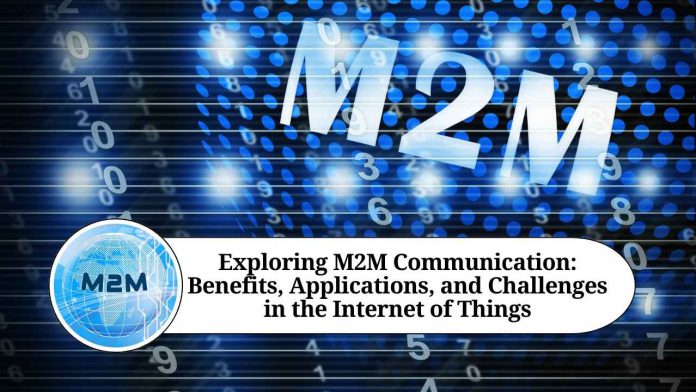Machine-to-Machine (M2M) Communication: A Comprehensive Guide
In today’s interconnected world, machines are increasingly being used to automate various processes in industries, transportation, healthcare, and many other areas. As a result, the need for seamless and efficient communication between machines has become more critical than ever. This is where machine-to-machine (M2M) communication comes in. In this blog, we’ll explore what M2M communication is, its benefits, and some of the technologies used for M2M communication.
What is M2M Communication?
Machine-to-machine communication (M2M) is a type of communication that enables devices and sensors to exchange information without human intervention. The communication can be wired or wireless and can occur over short or long distances. The goal of M2M communication is to enable machines to communicate and work together to achieve a common objective or improve operational efficiency.
Benefits of M2M Communication
M2M communication offers numerous benefits, including:
- Improved efficiency: M2M communication allows machines to work together seamlessly, which can lead to improved efficiency and productivity.
- Reduced costs: By automating processes and enabling machines to communicate with each other, M2M communication can help reduce costs associated with labor and human error.
- Enhanced safety: In industries such as healthcare and transportation, M2M communication can enhance safety by enabling real-time monitoring and alerts.
- Increased revenue: M2M communication can open up new revenue streams by enabling businesses to offer new services and products that leverage machine data.
Technologies Used for M2M Communication
There are several technologies used for M2M communication, including:
- Wireless Sensor Networks (WSNs): WSNs are networks of wireless sensors that can communicate with each other and a central node. They are commonly used for environmental monitoring and industrial automation.
- Cellular Networks: Cellular networks can be used for M2M communication by leveraging the existing infrastructure of mobile networks. Cellular networks are reliable and offer wide coverage, making them ideal for M2M communication.
- Wi-Fi: Wi-Fi can also be used for M2M communication, especially for devices that are located in close proximity to each other. Wi-Fi is easy to set up and offers high-speed data transfer rates.
- Bluetooth: Bluetooth is a short-range wireless communication technology that is commonly used for M2M communication in applications such as home automation and wearable devices.
M2M Communication in IoT
M2M communication is a critical component of the Internet of Things (IoT), which is the network of physical devices, vehicles, home appliances, and other objects that are embedded with sensors, software, and connectivity. In the context of IoT, M2M communication allows devices to exchange information with each other and with a central server, enabling real-time monitoring, analysis, and control.
Applications of M2M Communication
M2M communication has numerous applications across various industries, including:
- Healthcare: M2M communication can be used for remote patient monitoring, medication management, and medical device tracking.
- Transportation: M2M communication can enable real-time tracking of vehicles, logistics optimization, and fleet management.
- Industrial Automation: M2M communication can be used for predictive maintenance, equipment monitoring, and process optimization.
- Energy and Utilities: M2M communication can enable smart grid management, energy consumption monitoring, and remote asset management.
Challenges of M2M Communication
While M2M communication offers many benefits, it also comes with some challenges, including:
- Security: M2M communication can pose security risks, as devices may be vulnerable to hacking or unauthorized access.
- Interoperability: With the proliferation of different devices and technologies, ensuring interoperability between different M2M systems can be a challenge.
- Data Management: With the large amounts of data generated by M2M systems, managing and analyzing the data can be a significant challenge.
- Power Consumption: M2M devices often run on batteries, which can limit their lifespan and require frequent replacement.
Conclusion
M2M communication is a rapidly evolving technology that is transforming the way machines communicate and work together. As more devices become connected, the opportunities for M2M communication are only increasing. However, to fully realize the potential of M2M communication, it is essential to address the challenges of security, interoperability, data management, and power consumption. With continued innovation and investment, M2M communication is poised to play a significant role in shaping the future of technology and society.
Read more useful content:
Frequently Asked Questions (FAQs)
What is M2M communication?
M2M communication is a type of communication that enables machines and devices to exchange information without human intervention.
What are the benefits of M2M communication?
M2M communication offers several benefits, including improved efficiency, reduced costs, enhanced safety, and increased revenue.
What technologies are used for M2M communication?
Some of the technologies used for M2M communication include wireless sensor networks, cellular networks, Wi-Fi, and Bluetooth.
What is the difference between M2M communication and IoT?
M2M communication is a subset of IoT, which is the network of physical devices, vehicles, home appliances, and other objects that are embedded with sensors, software, and connectivity.
What are some applications of M2M communication?
M2M communication has numerous applications across various industries, including healthcare, transportation, industrial automation, and energy and utilities.
What are some of the challenges of M2M communication?
The challenges of M2M communication include security, interoperability, data management, and power consumption.
How does M2M communication improve efficiency?
M2M communication allows machines to work together seamlessly, reducing the need for human intervention and improving overall efficiency.
How does M2M communication enhance safety?
In industries such as healthcare and transportation, M2M communication can enable real-time monitoring and alerts, enhancing safety.
How is data managed in M2M communication?
Data generated by M2M systems is managed through various methods, including cloud-based platforms, data analytics, and data visualization tools.
What is the future of M2M communication?
As more devices become connected, the potential for M2M communication is only increasing. With continued innovation and investment, M2M communication is poised to play a significant role in shaping the future of technology and society.




















